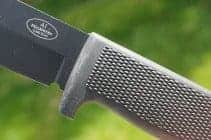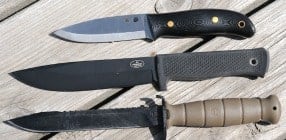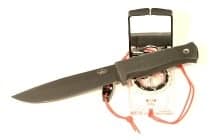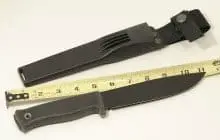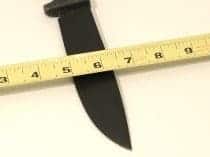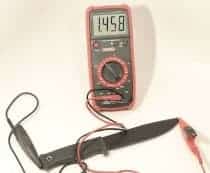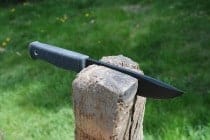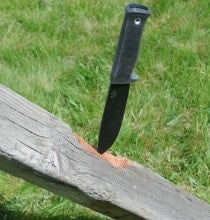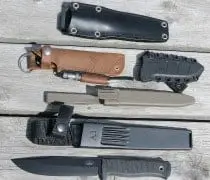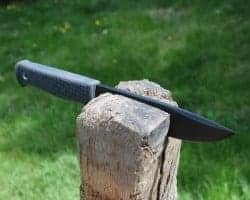
In 2002, in response to a question about the Iraq war, the US Secretary of Defense replied, and I paraphrase, “There are known knowns; there are known unknowns, but there are also unknown unknowns.” Those words are the best way to describe the the expectations of a survival knife. Especially the part about unknown unknowns. For contrast, a Swiss Army knife is completely full of knowns. There will be a #2 phillips-head screw in need of tightening. There will be a tin can in need of opening. And there will be a bottle of Merlot in need of uncorking. But with a survival knife, the easy parts are the knowns.
The hard parts, and those that separate real survival knives from those only advertised as such, are the unknown unknowns. Because if we knew the exact survival situation we were in for, we would avoid it in the first place.
| KNIFE | DETAILS | ||
|---|---|---|---|
|
Recommended
|
No products found.
|
|
Check Price on Amazon.com
|
SKIP AHEAD
Into the Unknown
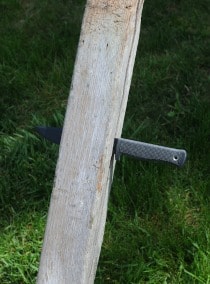
I enjoy the Youtube knife videos where a blade of some pedigree is stabbed through the hood of a car or into the door of a truck. Of course the usual question is “Why?” Followed closely by “So what?” Or in my case, “Now what?” Sure it’s true that even a cheap screwdriver will punch a hole in a hood or radiator, and I guess one could look at the metal penetration and even cinder block stabbing for that matter as a minimum standard for a survival knife, but mostly I’m just happy I got to enjoy the metal-on-metal or metal-on-stone violence in the video knowing it was not my knife being assaulted.
Wilderness survival expert Mors Kochanski defines a survival knife as, “A prybar that works wood really really well.” Therefore, a survival knife will be used for cutting, slicing, shaving chopping, digging, chipping, carving, hacking, trenching, splitting, scraping, grinding, drilling, smoothing, stabbing, and prying. Those are the knowns. Where a survival knife deviates from a hunting knife, a bushcraft knife, a combat knife, or a fighting knife is primarily in the blade thickness, length, grip, steel type and grind. Survival knives must excel in the realm of unknown unknowns. For that reason, most traditional and anticipated tasks are so obviously a part of the survival knife repertoire that they can be dismissed with little more than a single sentence in a knife review. So in that vein, the No products found. will easily, quickly and decisively gut a deer, chop meat, split firewood, shave arm hair, sharpen sticks, scrape a fire starter, and induce a second thought in would-be bad guys.
From Stone Chips to Super Steel
Some specialty purpose knives such as those for bushcraft and kitchen duties are heavily evolved designs that have been honed through centuries of subtle refinement. Survival knives, on the other hand, are created more through the reaction to ever-changing demands. In a nutshell, the 21st century survival knife is a combination of traits hand-picked from a number of other knife sources. The survival blade must be a fighter, a camper, a utility knife, and a general tool for outdoor tasks. Further, the so-called “survival knife” morphs from one variant to another based upon the geography of use. Jungle survival knives draw upon their machete roots, while northern climate survival blades lean on past fighting designs with hints of bushcraft. Survival steels want to be stainless for obvious care reasons, but also must play well with sharpeners. Intensely serious survival knives such as the No products found. have a solid footing in both worlds with their amazing blade laminates of two totally different metals.
The No products found. is not a beginner’s knife. Of course it would work as such, but the life-saving features of the A1 are not as obvious as an accessory-filled sheath, a blade covered with characteristics more common to a survival knife infographic. Instead the No products found. is exactly what you would expect a black ops operator to pull from a minimalist sheath during your rescue. Frankly, the A1 is what I would expect James Bond to wear in his the next movie. The no-nonsense A1 subtly screams that it means business. So much so that the stately design is much copied. And like the RamBowie, the A1’s profile is a meme for “survival knife.”
| KNIFE | DETAILS | ||
|---|---|---|---|
|
Recommended
|
No products found.
|
|
Check Price on Amazon.com
|
Memory Lane:
Years ago, the so-called survival knife was only for fighting. Keeping one’s distance was essential so the knife was a sword, a machete or a Bowie. Which, by the way, Jim Bowie using a Bowie knife proved at the Sandbar Duel that bringing a knife to a gunfight can work as long as your enemies are bad shots, and the other knives are more ornamental than deadly.
As guns gained reloadability and accuracy, the blades got shorter. Trench warfare required a fighting blade for enclosed spaces and bayonets were the steel de jure. Long narrow blades were excellent for thrusting into the enemy, but not so good for daily knife work which was fast becoming the new norm. As bayonets went the way of the trenches and were replaced by reliable handguns, so too did the concept of a survival knife being of long narrow double or triple edged steel.
The survival pressures on the duty blade pushed it towards something that could fight with both man and machine, as well as contribute to the housekeeping chores while on the lamb. As warfare became more mechanized, the survival blade took on the shape of a short Bowie or Saber form with a thicker spine. Soon, the design became a victim of standards demanded from it rather than a choice from what was available. As the specifications hardened into government requirements, the pool of survival blade shapes converged on a smaller saber-like shape or spear-point with accoutrements such as saw teeth on the spine, guards separating blade and handle, electrically non-conductive grips, and a hammer-like pommel. In other words innovation took a backseat to procurement proposals.
Sweden Knows Survival:
Sweden is more than Saab, Volvo and ABBA. And yes, Ikea and Hasselblad are two other popular Swedish exports, but if you look in your survival kit, you might find a few other Swedes hanging around including Mora Knives and Swedish Firesteel. In fact the Swedish company Husqvarna is well known for chainsaws and lawn mowers, but back in 1689 Husqvarna made some of the finest muskets in the world. And even today the Husqvarna logo is still a gunsight. So with the same no nonsense traditions that created Spotify, Skype, Aimpoint red dot sights, and the oldest standing army in the world, the Swedes also make one of the finest survival knives with the No products found..
Compared to hunting and bushcrafting blades, the A1 is a beast, but not so beastly to be mistaken for a Rambo-complex knife. At almost a foot long and three-quarters of a pound heavy, the A1 is a formidable chunk of edged hardware. Its near quarter-inch thickness has sustained loads in break tests well over 500 pounds where the load was placed half-a-foot out from the fulcrum.
And if size alone weren’t enough, the blade steel is actually of sandwiched construction, or laminate in knife lingo. Two different metal alloys are layered; one that is softer and more stain resistant surrounding a harder and thus more brittle traditional edge steel. In the case of the A1, it is highly proven VG10 steel for the edge, blanketed in 420J2 stainless steel. Combining multiple steels in a single blade is not new. In fact, laminate steel blades were used centuries ago by another Swedish export, the Vikings!
Steel This:
VG10 steel is well known for having excellent durability and edge holding properties. It’s Rockwell hardness is around 59 give or take a point. Spyderco is a heavy user of VG10, and has globally popularized its application in outdoor knives. VG10 is primarily a Japanese steel borne of the history of edged weapons that are so deeply a part of the Samurai culture in Japan. As a high carbon stainless steel, VG10 brings an excellent resume to the job of survival knife, and since the Japanese are the world’s experts in VG10 steel production, Fallkniven has contracted to have the blades forged by the Takefu Special Steel Company of Japan. VG10 is a proprietary alloy including 1% Carbon, 15% Chromium, 1.5% Cobalt, 1% Molybdenum, and 0.2% Vanadium among the usual metal suspects. Due to the quality and precision of the steel’s composition, it is one of those so-called “Super Steels.”
Walking the Razor’s Edge:
The necessities of a survival knife compared to other specific-use knives include that the survival blade must perform well for an extended period without needing to be touched up, and yet take a new edge easily when time permits. Harder steels might have better edge retention, but are more brittle and require much greater effort to resharpen. On the other side, softer steels are fast to sharpen and usually take a better edge, but demand such attention more often. And to complicate things further thus providing endless fodder for blade steel arguments, the nuances of how the blade responds to injury (dull, roll, chip, etc.), how it handles neglect (rust, pitting, staining, etc.), and the degree of sharpness the blade will accept before hitting its personal point of diminishing return are all fair game questions. So the true ‘survival’ aspects of a knife are found at the simple intersection of use and maintenance.
For example, the best-case scenario for a fighting knife is an extreme but short term use before scheduled maintenance. While bushcraft knives, on the other hand, are for prolonged use for generally low to medium edge stress challenges. A survival knife must have attributes of both since survival could be either short or long term, and the blade must serve well for precision bushcraft and vicious attacking.
There is also a tradeoff between blade length and thickness. The longer the blade, the more leverage that can be generated. The more leverage, the greater chance of breaking the blade. A short thick blade is like a chisel. A long thin blade is like a kitchen knife. A fighting knife leans more towards the long-thinner meat cutting side, while a bushcraft knife is on the shorter-thicker utility side. A survival knife such as the A1 is a variation by taking the thickness of a bushcraft blade and extending its length more towards the fighting knife, then revisiting the thickness to make it complement the added length. That makes for a heavier, stouter blade that blasts through most harsh cutting chores yet without the knife’s size interfering with the task. However gutting a fish that’s smaller than your knife is not quite comical, but neither is it graceful.
A different trajectory on length is taken by some mainstream survival knives where a softer blade steel is chosen to reduce the chance of breakage. Instead the blade will bend under load while still retaining its basic cutting abilities. Anticipated bending is not new, nor is it without historical precedence since a major breakthrough in Viking sword technology was a flexible blade that didn’t snap when stuck in an enemy’s shield. However, others argue that deliberate blade softness in a survival knife is a sacrilegious deviation from proper forging. And still others would prefer a blade that chips over one that rolls because chipping is like manufacturing your own serrations which means the knife will cut, albeit raggedly. But the real question is WWRD? What would Rambo do?
Rambo Blades:
Let’s pause for a little background: Rambo used a modified Bowie designed by Jimmy Lile in the movie First Blood. The overall length of the knife was just short of 14 inches with nine of those inches a flat grind edge of D2 steel. Fourteen saw teeth graced the spine of the blade, and the hollow pommel was wrapped with 36 feet of green paracord. By the second Rambo movie – No products found., the Lile-Rambo knife had grown to over 15 inches in length with a 10-inch blade. The bead-blasted finish of the first movie’s knife was swapped out for a Hollywood contradiction of shiny edges surrounding a blackened center creating a silhouette of a smaller blade within a larger one. The number of saw teeth on the spine remained the same, but looked slightly less ridiculous since they stopped further back from the tip.
By the third movie – Rambo III, the knife grew to a full Bowie on steroids with a blindingly shiny 440 stainless blade of massively wide girth and a foot of blade length. Sly Stallone, a knife aficionado in his own right, asked Gill Hibben to design the Rambo III blade. The grip was again wrapped in paracord, but this time it had finger grooves reminiscent of the bicycle handlebar grips on a Schwinn Stingray which is where Hibben likely got his inspiration. The handle has a huge stainless steel handguard on one side and an equally conspicuous stainless buttcap on the other. In the end, Stallone did to knives what Schwarzenegger did to Hummers; he popularized packing a huge knife even if terribly inefficient for the job at hand. On the flip side of that same coin, the mere presence of such a mean looking battleknife may defuse a situation regardless if the carrier knows how to use it or not. Kind of like the open carry of a handgun; it can remind other folks to mind their manners.
The fourth Rambo movie resorted to a crude machete/cleaver looking thing. Since Rambo supposedly forged the knife himself, the beauty of the absurd Rambo Bowie appears over…until Rambo 5?
The Fallkniven A1 Review
For the uninitiated, the size of the No products found. (pronounced Faill-Knee-ven (make the k sound)) might raise a few eyebrows when you unsheath it to sharpen up some marshmallow sticks, but the A1 is hardly a monster by modern standards. The 6.3 inch cutting surface is plenty for most tasks, and perfect for others, while hardly a burden for dainty jobs like scraping a leech off your jugular (see the second Rambo movie).
The A1 has a rubbery textured Kraton grip with a single lanyard hole penetrating the knife handle just shy of the heel. A metal beam protrudes out the end of the grip demonstrating the extended tang seriousness of this knife, which is nothing more than a full tang that goes all the way through the handle and keeps on going. To test the presence of a solid full tang, use the continuity setting on a multimeter. Some knives that appear to have full or extended tangs don’t. For instance, the popular Gerber LMF II feels like a full tang knife, but in order to meet the electrically insulative requirement of a military egress knife, there is a small portion of polymer separating the blade steel from the angular buttcap.
| KNIFE | DETAILS | ||
|---|---|---|---|
|
Recommended
|
No products found.
|
|
Check Price on Amazon.com
|
The Kraton handle on the A1 is a grippy, rubber-like material that is a very popular interface between tool and human hand. It has excellent handling qualities that are generally more durable than naturally sourced material like wood or leather, as well as providing a more secure grip when elbow-deep in blood and guts.
There have been some internet rants about Kraton grips becoming excessively tacky, but in most cases they have been traced to cheap Chinese imports that claim to be Kraton, but may actually be more a kraton-like plastic given their sensitivity to chemicals, UV light, and time. True Kraton grips as are on the A1 have proven themselves worthy in survival situations and battles alike across many major knife manufacturers and continents.
Some armchair aficionados scoff at the choice of the Fallkniven A1 as the official survival knife of the Swedish Air Force. Not because of the knife, but because of the status of the Air Force today compared to its rank as fourth most powerful in the world back in 1957. Seriously, how many non-flyers can name with certainty the current United States Air Force survival knife? Even if named, few carry them while on the ground due to their limited camp functions, soft blade, propensity to rust unless heavily coated, leather-washer or rubber handle, mundane 1095 carbon steel, and general need to be paired with a smaller second knife to fulfill all survival cutting and fire starting chores. Not that it’s a bad knife, in fact just the opposite as many military folks will swear to. It just happens that the Aircrew Survival Egress Knife or ASEK for short is more of an emergency knife compared to an everyday use knife that doubles as an extreme survival knife like the Fallkniven A1. One additional caveat in this comparison is that the USAF likely had to jump through the hoop of lowest bidder. With the Fallkniven A1, expense appears not to have been a major consideration.
The A1 in Hand
The first thing you will notice when unsheathing the No products found. is that it feels much more like a serious piece of steel attached to a handle compared to a grip with a blade attached. In other words, the stout, dense, heavy feeling of the blade is obvious through the handle. In fact, even though covered by Kraton, the grip of the A1 is closer to a raw paracord grip than a cushy handle of wood, leather, G-10 or even thicker Kraton.
The handle size is often a topic of reviews with a majority of users leaning toward the desire for a larger grip. If you have large or extra large mitts, you might notice that the A1 grip is slightly smaller than some other serious survival knives, but there are advantages to going smaller than erring on the side of large. No matter what, you will have a fully wrapped hand around this grip where a larger handle might make a secure hold less likely. Like a quality pistol grip, your fingers must fully consume the grip to best control the weapon. This is a survival knife, not a garden shovel. Plus, if you add a layer of glove between your hand and the knife, the larger handle might be too big to hang on to with your life. And while on the subject, if you carry the excellent Swedish Firesteel, try to make sparks using the small included striker when your fingers are numb with cold. Guess what? You can’t! Instead you will want a striker about the size of the A1 knife. Then the challenge will be to hold onto the fire rod.
The flow of energy between your movements and the blade’s response is critical for fine motor tasks. The A1’s blade is thick but not long so it remains under complete control even when gently building precision snares by boring holes and carving trigger sticks. But in a flash, the A1 could slam six inches of iron alloy through any post-cretaceous rib cage. The same edge that whittles feather sticks with cold hands, could bust the sternum of an elk, or chop through a wooden door, or theoretically bash its way out of a cracked polycarbonate airplane canopy (my Air National Guard friends agreed, but didn’t have any cracked canopies for me to test).
Batoning and chopping are too easy for the A1 to qualify as serious tests. With a weight-forward design and thick hefty blade, the A1 slices through wood like a small axe, and chops very much like a hatchet. Enough said about that. Of course its a knife so your mileage may vary, but whacking away on wood seems so natural for the A1 that you forget about the tool while lost in the chopping moment.
The more frugal among us have already done the math and realized that you could buy a nice knife, a nice axe, and a nice hatchet for less than the price of the A1. So why get the Fallkniven? Great question, and one that always comes up when a knife’s price moves north of two digits…in this case two clicks north. With the A1, the concept should be that you have a collection of very high quality tools all within the weight, size, and most importantly availability of one tool.
Let’s use the Vikings for example. When going into battle with man or nature, the instant of contact will only allow for one weapon. The concept behind carrying a backup blade is based upon anticipated failure of your first choice. Not that a Plan B is unnecessary, but the reason Plan A is the primary is because it’s the best option given the possibilities. The Vikings wanted blades that could chop opposing swords and shields in half. A secondary knife was often carried, but in the heat of the battle swapping edges was literally the last resort, and most likely not much of a resort at all. Today’s operator backs up his rifle with a sidearm, and backs up the sidearm with a knife. Then what? Should the primary blade be backed up with a smaller blade? Then yet another smaller one? Sure, two is one and one is none, but in my survival book, two of anything low quality is also none. So ask yourself, do I feel lucky…or prepared?
Sheath Talk:
Rarely is a production sheath embraced with the same gusto as the blade, and thus is the story with the A1. Personally I think Fallkniven could avoid most complaints about the minimalist version of their sheath by actually charging customers an extra $10 for it. Then the survival glitterati would sing the praises of this inexpensive and functional sheath instead of lambast it’s shortcomings. But as it stands the list of features missing from this sheath is far longer than those it contains making it an easy target for opinions.
The folks who lean towards the glass being half full will relish in the simplicity of the sheath. It’s injection molded Zytel form is a near-featureless blade cover barely larger than the knife. A single webbing and snap handle strap secures the system supplementing a friction lock that requires a mild jerk or thumb pry to separate the knife from the sheath. The thumb ramp is designed for a right-hand carry, but a left-handed sheath is also available. The oversized webbing belt loop is twice riveted in place. Five moulded strengthening fins break up the monotony on both sides of the black plastic, and a single inch-wide horizontal eyelet completes the southern top of this blade case.
From an operational standpoint, the sheath does its job effectively, but Fallkniven also sells the A1 with an equally bland leather sheath. Further, the aftermarket landscape is rich with other A1 sheath options from the most basic designs to those tactical and feature-rich enough to satisfy the most OCD survivalist, and might even double the overall operational cost of this knife.
In one test, I carried the A1 knife in the Zytel sheath round-the-clock for a week while adventuring in Alaska. I found the weight and size of the knife and sheath quite comfortable except in two regards. First, the sheath hangs slightly low, just enough to get in the way when sitting, but not quite low enough to tie off with a thigh strap. Second, the loose webbing beltstrap was, well, a little too loose. The knife easily moved around which made it simple to move out of the way when sitting quick, but I’d rather have the sheath hold a tighter grip on my 5.11 tactical belt and not require further attention when my position changed. On the positive side, the loose sheath slid out of the way quickly when prone or crawling, but tended to always drift towards the center of the earth getting in the way and necessitating a quick adjustment when rolling over, scooting around on my butt, or crawling backwards. Thoughts of tire spikes came to mind. As long as I was moving forward things were great, but the moment I reversed direction, the sheath would ratchet into the rocks or ground impeding progress.
To Coat or not to Coat:
The No products found. is available as either shiny stainless or as a black Ceracoated version. Ceracoat is a ceramic coating that provides additional layers of protection both for the blade and you. As a less reflective option, stray light flashes are reduced, and some additional corrosion resistance is added. And for those really in a bad spot, the thermal signature of the knife is lowered somewhat, but I didn’t get around to testing that.
Final Cut:
The choice of a survival knife is a personal one, and luckily there are more fine options now than ever before. The Fallkniven A1 is a classic, proven design, and yes, an arguably expensive option. But in the end we must keep our survival equipment grounded in reality and make our first choice our best choice because it might be our last choice.
| KNIFE | DETAILS | ||
|---|---|---|---|
|
Recommended
|
No products found.
|
|
Check Price on Amazon.com
|


